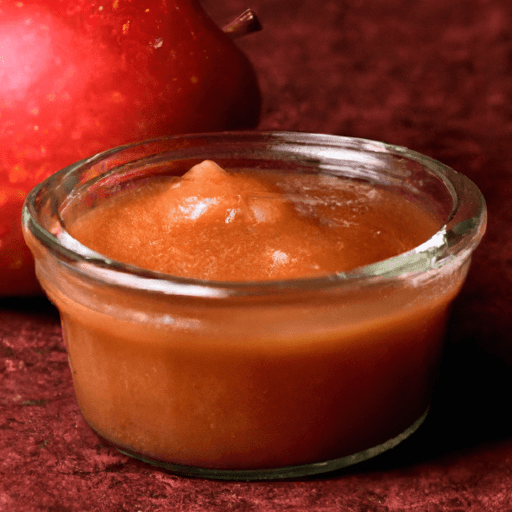The Delightful World of Apple Sauce
Applesauce, a humble and versatile condiment, has been gracing our tables and tantalizing our taste buds for centuries. Made from steeped, pureed, or cooked apples, this velvety delight brings a unique burst of fruity goodness to both sweet and savory dishes. Whether you enjoy it on its own, pair it with a hearty main course, or use it as a secret ingredient in your baking, applesauce undeniably deserves a top spot in your pantry.
The Taste Sensation
Apple sauce boasts a pleasant balance of natural sweetness and tartness. The flavor profile will vary depending on the variety of apples used – from mildly sweet to mildly tangy or occasionally a touch of both. The smooth texture and velvety consistency make it a joy to incorporate into recipes or simply savor straight from the spoon.
Versatility in Cooking
Applesauce offers a myriad of culinary possibilities. Its sweet and tangy qualities make it a fantastic accompaniment to roasted meats, such as pork or chicken, adding a burst of freshness. It’s also a remarkable binder and moisture retainer in baking, replacing eggs, oil, or butter to create healthier treats without compromising taste or texture.
Additionally, applesauce serves as a fantastic base for dressings, marinades, and even vinaigrettes, lending a subtle fruitiness to enhance the overall flavor profile. Its versatility knows no bounds, making it a cherished ingredient in both traditional and modern cuisine.
Nutritional Benefits
Aside from its incredible taste and culinary uses, applesauce is also a nutritional powerhouse. Made with whole apples, this condiment retains the fruit’s essential vitamins, minerals, fiber, and antioxidants. It’s low in calories and fat while providing a natural sweetness that can help reduce the need for added sugars in recipes.
The soluble fiber found in applesauce can aid digestion and promote a healthy gut. It’s also a rich source of immune-boosting vitamin C. So, by incorporating applesauce into your meals and baking, you’re not only treating your taste buds but also giving your body a nutritious boost.
A Dash of History and Fun Facts
Apple sauce traces its roots back to medieval Europe, where it was first made as a medicinal concoction rather than a culinary delight. Early versions involved drying apples and rehydrating them with water before turning them into a puree. Over time, it evolved into the smooth sauce we know and love today.
In America, applesauce gained popularity during the 19th century. As apple orchards thrived, families began preserving apples by canning and turning them into sauce. It became a staple in households due to its long shelf life and versatility.
When it comes to fun facts, did you know that applesauce can act as a natural egg replacer in vegan baking? It adds moisture and binding properties to achieve delicious, plant-based treats. Additionally, applesauce is an excellent choice for parents introducing solid foods to their babies, providing them with essential vitamins and a gentle introduction to natural flavors.
Embrace the Apple Sauce Magic
The simplicity and versatility of applesauce make it an invaluable addition to any kitchen. So, next time you come across this velvety creation, be sure to grab it, explore the countless culinary possibilities, and savor the delightful taste while reaping the nutritional benefits. Whether you’re using it to dress up a savory meal or to enhance a batch of freshly baked goodies, applesauce remains a timeless and irresistible favorite for food enthusiasts and cooks alike.
Now, go forth and discover the magic of applesauce in your own cooking adventures!
Origin of Applesauce
- Applesauce has a long history and can be traced back to ancient Rome and Greece.
- It is believed to have been prepared by stewing apples and then mashing them into a sauce-like consistency.
- Applesauce was a popular dish in medieval Europe, where it was often flavored with spices such as cinnamon, nutmeg, and cloves.
- The popularity of applesauce spread to America, where it became a common condiment and ingredient in various dishes.
Common Uses of Applesauce
- Applesauce is commonly used as a condiment and ingredient in cooking and baking.
- It is often used as a topping or accompaniment to dishes like pork chops, latkes, and oatmeal.
- Applesauce is a popular ingredient in baking because it can be used as a substitute for oil or butter in recipes, reducing the fat content.
- It is also used as a sweetener and flavor enhancer in various recipes, such as cakes, muffins, and bread.
Nutritional Benefits of Applesauce
- Applesauce is low in calories and fat, making it a healthy option for those watching their weight.
- It is a good source of dietary fiber, which aids in digestion and helps maintain a healthy digestive system.
- Applesauce contains vitamins and minerals, including vitamin C, potassium, and antioxidants that support overall health.
- It is a naturally sweetened alternative to processed sugars, making it a preferred option for those looking to reduce their sugar intake.
Unique Properties and Historical Significance of Applesauce
- Applesauce has a smooth texture and a mildly sweet flavor that appeals to both children and adults.
- It was traditionally made using a food mill or sieve to remove the skins and seeds, resulting in a smooth and uniform consistency.
- In the 19th century, applesauce was often served as a side dish with meat to add moisture and complement the savory flavors.
- In Jewish cuisine, applesauce is often served alongside latkes (potato pancakes) as a traditional accompaniment.
- Applesauce is also used as a baby food for infants transitioning to solid foods due to its soft texture and natural sweetness.
Note: While applesauce has a rich history and is commonly used worldwide, specific cultural and regional variations in its preparation and uses may exist.




Use the share button below if you liked it.
It makes me smile, when I see it.